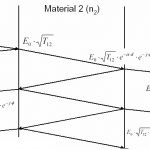
The Role of Precision Optics In Military, Defense, and Security
Tuesday, 1 September, 2020
Interferometry: What you need to know
Monday, 21 September, 2020Surface Quality: What you need to know.
Surface quality is a primary quality parameter for precision optical components. This is because precision optics have many applications that demand extremely high performance and sometimes operate in extreme intensities of laser light. But perfection is not attainable, which is why we specify “tolerances,” and why we speak of “imperfections” instead of “defects.” A defect is an imperfection that falls outside of tolerance. The glasses we put over our own eyes to see the world would almost certainly not pass most “standard” specifications for precision optics’ surface quality, but we tolerate them, and are even delighted with new prescriptions, because they are every bit as good as they need to be.
So how good do your precision optics’ surfaces need to be?
What are surface imperfections?
Surface imperfections fall into two categories – Areal and Localized.
Areal imperfections are those that extend over a sizable area of the surface, and are typically caused by chemical effects in polishing, cleaning, or storage. These include stains, dimming, and fogging.
- A stain is a discolored area, typically blue or yellow on an uncoated surface and any color different from the coating on a coated surface.
- Dimming is a darker, less-reflective area on an uncoated surface.
- Fogging is a hazy or cloudy area.
Localized imperfections include scratches, digs, edge chips, and fractures. They extend into the surface and are caused by impact or abrasive action.
- A scratch is a narrow score mark. It may be short or nearly as long as the full surface, and may be curved, straight, or zig-zag. It may be evaluated by its apparent brightness and length, or its measured area.
- A dig is a small crater or pit. It is evaluated by the diameter of the smallest circle surrounding it.
- An edge chip is that region where a sliver of material has separated from the edge. Chips may be evaluated by a formula including their radial dimension, number, and/or accumulated circumferential extent.
- A fracture is a crack into the surface. Unlike a chip in which the entire sliver has been removed, a fracture can continue to grow. Fractures of any size are unacceptable for that reason.
The Standards of surface quality
While many nations have their own Standards, the two currently dominant Standards are the American military MIL-PRF-13830B and the international ISO 10110-7. The MIL is presently more familiar to most American shops and is more subjective in its evaluation by comparative appearance. The ISO is more quantitative and gaining wider adoption. They both explicitly define criteria for stains, dimming, fogging, scratches, digs, and edge chips, while describing and notating them in somewhat different ways.
Adverse effects of imperfections
When surface quality is not sufficient, performance degrades. Damage to the optics or the entire system is possible.
Scratches and digs scatter light. In an imaging system this is usually a small concern – unless the surface of concern is near a focal plane. In that case they will show up as features in the image like floaters in one’s eye. But in a laser system they can concentrate the light, heat the optic, and crack or melt it. And in what are called “intracavity optics” they can scatter enough light to reduce the laser power or diffract it and compromise the beam’s coherence.
Stains, dimming, and fogging are signs of chemical damage or poor cleaning. They can shorten the life of an optic, or scatter light resulting in poor contrast and reduced brightness.
Edge chips may interfere with mounting accuracy or vacuum-sealing. This is a quantitative mechanical tolerance that can be checked against the mechanical mount dimensions. Also, since they are shiny, they can cause spurious and unpredictable bright spots inside the instrument. Typically, acceptable edge chips are “stoned” with an abrasive stick to dull their finish.
Fractures can grow with stress and strain. In a porthole window, a fracture can cause a breach resulting in injury or death.
Adverse effects of over-specifying
There are dangers in over-specifying as well. Qualified vendors may decline your order. They may accept, but at a substantially higher price. It may take them longer to deliver to a more stringent quality. And minor cosmetic degradation at the end of production can cause unanticipated and long delays for re-manufacture. That can shut down your entire production line.
And once you get the components, your incoming quality department may dispute more of those expensive items.
Work with the experts
It must be said that while either MIL-PRF or ISO 10110-7 can specify a surface quality tolerance and determine mutually agreeable acceptance criteria, both are only cosmetic standards; neither is a performance standard.
When specifying a resistor to be 1kW ± 5%, you can look at your circuit diagram and do some calculations and decide if 5% will give the performance you want. But, if you specify surface quality to be SD 20-10, there is no book to tell whether what you’re ordering is good enough, or whether you’re overpaying.
Experts with long experience in precision optics are needed to ensure that the chosen tolerances are the right ones.
Partner with Tower Optical Corporation
If you’re looking for a highly-experienced team, premium quality, and an unwavering commitment to excellence, partner with Tower Optical for even the most demanding applications. From concept to the final product, this leading precision optics manufacturer ensures quality and precision throughout.
With custom-manufacturing capabilities and an inventory of in-stock items, they provide a variety of products to industry experts all over the world. Among their portfolio are beamsplitters, optical filters, optical windows, beam expanders, laser mirrors, and over 10,000 waveplates.
Send them a drawing of your optical solution and they’ll reach out to you with a quotation.



